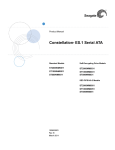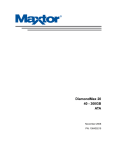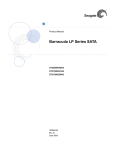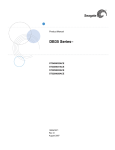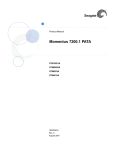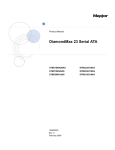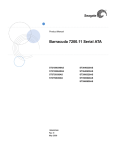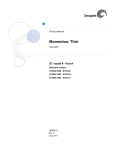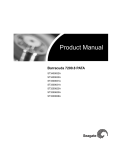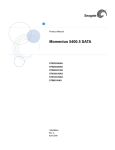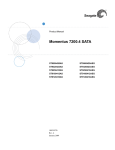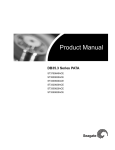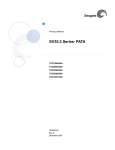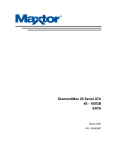Download Seagate DiamondMax 21 200GB Hard Disk Drive
Transcript
Product Manual DiamondMax 21 PATA STM3320820A STM3200820A STM3300620A STM3160215A STM3250620A STM380215A STM3250820A 100451230 Rev. B September 2007 Revision status summary sheet Revision Date Sheets Affected Rev. A Rev. B 11/16/06 09/21/07 Initial Release. Front cover, 1, 3, 8-13, 16-18, 22 and 33. Copyright © 2006, 2007 Seagate Technology LLC. All rights reserved. Printed in U.S.A. Publication number: 100451230, Rev. B September 2007 Seagate, Seagate Technology and the Wave logo are registered trademarks of Seagate Technology LLC in the United States and/or other countries. DiamondMax, MaxBlast, Maxtor and the Maxtor logo are either trademarks or registered trademarks of Seagate Technology LLC or one of its affiliated companies in the United States and/or other countries. All other trademarks or registered trademarks are the property of their respective owners. One gigabyte, or GB, equals one billion bytes when referring to hard drive capacity. Accessible capacity may vary depending on operating environment and formatting. Seagate reserves the right to change, without notice, product offerings or specifications. Contents 1.0 Introduction. . . . . . . . . . . . . . . . . . . . . . . . . . . . . . . . . . . . . . . . . . . . . . . . . . . . . . . . . . . . . . . . . . . 1 2.0 Drive specifications . . . . . . . . . . . . . . . . . . . . . . . . . . . . . . . . . . . . . . . . . . . . . . . . . . . . . . . . . . . . 3 2.1 Specification summary tables . . . . . . . . . . . . . . . . . . . . . . . . . . . . . . . . . . . . . . . . . . . . . . . 3 2.2 Formatted capacity . . . . . . . . . . . . . . . . . . . . . . . . . . . . . . . . . . . . . . . . . . . . . . . . . . . . . . 10 2.2.1 LBA mode . . . . . . . . . . . . . . . . . . . . . . . . . . . . . . . . . . . . . . . . . . . . . . . . . . . . . 10 2.3 Default logical geometry . . . . . . . . . . . . . . . . . . . . . . . . . . . . . . . . . . . . . . . . . . . . . . . . . . 10 2.4 Recording and interface technology . . . . . . . . . . . . . . . . . . . . . . . . . . . . . . . . . . . . . . . . . 11 2.5 Physical characteristics . . . . . . . . . . . . . . . . . . . . . . . . . . . . . . . . . . . . . . . . . . . . . . . . . . . 11 2.6 Seek time. . . . . . . . . . . . . . . . . . . . . . . . . . . . . . . . . . . . . . . . . . . . . . . . . . . . . . . . . . . . . . 12 2.7 Start/stop times . . . . . . . . . . . . . . . . . . . . . . . . . . . . . . . . . . . . . . . . . . . . . . . . . . . . . . . . . 12 2.8 Power specifications . . . . . . . . . . . . . . . . . . . . . . . . . . . . . . . . . . . . . . . . . . . . . . . . . . . . . 13 2.8.1 Power consumption . . . . . . . . . . . . . . . . . . . . . . . . . . . . . . . . . . . . . . . . . . . . . . 13 2.8.2 Conducted noise . . . . . . . . . . . . . . . . . . . . . . . . . . . . . . . . . . . . . . . . . . . . . . . . 14 2.8.3 Voltage tolerance . . . . . . . . . . . . . . . . . . . . . . . . . . . . . . . . . . . . . . . . . . . . . . . . 14 2.8.4 Power-management modes . . . . . . . . . . . . . . . . . . . . . . . . . . . . . . . . . . . . . . . . 15 2.9 Environmental specifications . . . . . . . . . . . . . . . . . . . . . . . . . . . . . . . . . . . . . . . . . . . . . . . 16 2.9.1 Ambient temperature . . . . . . . . . . . . . . . . . . . . . . . . . . . . . . . . . . . . . . . . . . . . . 16 2.9.2 Temperature gradient. . . . . . . . . . . . . . . . . . . . . . . . . . . . . . . . . . . . . . . . . . . . . 16 2.9.3 Humidity . . . . . . . . . . . . . . . . . . . . . . . . . . . . . . . . . . . . . . . . . . . . . . . . . . . . . . . 16 2.9.4 Altitude . . . . . . . . . . . . . . . . . . . . . . . . . . . . . . . . . . . . . . . . . . . . . . . . . . . . . . . . 16 2.9.5 Shock . . . . . . . . . . . . . . . . . . . . . . . . . . . . . . . . . . . . . . . . . . . . . . . . . . . . . . . . . 17 2.9.6 Vibration . . . . . . . . . . . . . . . . . . . . . . . . . . . . . . . . . . . . . . . . . . . . . . . . . . . . . . . 17 2.10 Acoustics . . . . . . . . . . . . . . . . . . . . . . . . . . . . . . . . . . . . . . . . . . . . . . . . . . . . . . . . . . . . . . 18 2.11 Electromagnetic immunity . . . . . . . . . . . . . . . . . . . . . . . . . . . . . . . . . . . . . . . . . . . . . . . . . 19 2.12 Reliability . . . . . . . . . . . . . . . . . . . . . . . . . . . . . . . . . . . . . . . . . . . . . . . . . . . . . . . . . . . . . . 20 2.12.1 Annualized Failure Rate (AFR and Mean Time Between Failures (MTBF) . . . . 20 2.13 Agency certification . . . . . . . . . . . . . . . . . . . . . . . . . . . . . . . . . . . . . . . . . . . . . . . . . . . . . . 20 2.13.1 Safety certification . . . . . . . . . . . . . . . . . . . . . . . . . . . . . . . . . . . . . . . . . . . . . . . 20 2.13.2 Electromagnetic compatibility. . . . . . . . . . . . . . . . . . . . . . . . . . . . . . . . . . . . . . . 20 2.13.3 FCC verification . . . . . . . . . . . . . . . . . . . . . . . . . . . . . . . . . . . . . . . . . . . . . . . . . 21 2.14 Environmental protection . . . . . . . . . . . . . . . . . . . . . . . . . . . . . . . . . . . . . . . . . . . . . . . . . . 22 2.14.1 European Union Restriction of Hazardous Substances (RoHS) Directive . . . . . 22 2.14.2 China Restriction of Hazardous Substances (RoHS) Directive . . . . . . . . . . . . . 22 2.15 Corrosive environment . . . . . . . . . . . . . . . . . . . . . . . . . . . . . . . . . . . . . . . . . . . . . . . . . . . 22 3.0 Configuring and mounting the drive . . . . . . . . . . . . . . . . . . . . . . . . . . . . . . . . . . . . . . . . . . . . . 3.1 Handling and static discharge precautions . . . . . . . . . . . . . . . . . . . . . . . . . . . . . . . . . . . . 3.2 Breather filter hole precautions . . . . . . . . . . . . . . . . . . . . . . . . . . . . . . . . . . . . . . . . . . . . . 3.3 Jumper settings . . . . . . . . . . . . . . . . . . . . . . . . . . . . . . . . . . . . . . . . . . . . . . . . . . . . . . . . . 3.3.1 Master/slave configuration . . . . . . . . . . . . . . . . . . . . . . . . . . . . . . . . . . . . . . . . . 3.3.2 Cable-select option . . . . . . . . . . . . . . . . . . . . . . . . . . . . . . . . . . . . . . . . . . . . . . 3.3.3 Ultra ATA/100 cable . . . . . . . . . . . . . . . . . . . . . . . . . . . . . . . . . . . . . . . . . . . . . . 3.4 Drive mounting . . . . . . . . . . . . . . . . . . . . . . . . . . . . . . . . . . . . . . . . . . . . . . . . . . . . . . . . . 23 23 24 25 25 25 26 26 4.0 ATA interface . . . . . . . . . . . . . . . . . . . . . . . . . . . . . . . . . . . . . . . . . . . . . . . . . . . . . . . . . . . . . . . . 4.1 ATA interface signals and connector pins . . . . . . . . . . . . . . . . . . . . . . . . . . . . . . . . . . . . . 4.1.1 Supported ATA commands . . . . . . . . . . . . . . . . . . . . . . . . . . . . . . . . . . . . . . . . 4.1.2 Identify Device command. . . . . . . . . . . . . . . . . . . . . . . . . . . . . . . . . . . . . . . . . . 4.1.3 Set Features command . . . . . . . . . . . . . . . . . . . . . . . . . . . . . . . . . . . . . . . . . . . 4.1.4 S.M.A.R.T. commands . . . . . . . . . . . . . . . . . . . . . . . . . . . . . . . . . . . . . . . . . . . . 29 29 30 32 35 36 5.0 Maxtor support services . . . . . . . . . . . . . . . . . . . . . . . . . . . . . . . . . . . . . . . . . . . . . . . . . . . . . . . 37 DiamondMax 21 PATA Product Manual, Rev. B i ii DiamondMax 21 PATA Product Manual, Rev. B List of Figures Figure 1. Figure 2. Figure 3. Figure 4. Figure 5. Figure 6. Figure 7. Typical 5V startup and operation current profile . . . . . . . . . . . . . . . . . . . . . . . . . . . . . . . . . . . Typical 12V startup and operation current profile . . . . . . . . . . . . . . . . . . . . . . . . . . . . . . . . . . Breather filter hole location . . . . . . . . . . . . . . . . . . . . . . . . . . . . . . . . . . . . . . . . . . . . . . . . . . . Master/slave jumper settings . . . . . . . . . . . . . . . . . . . . . . . . . . . . . . . . . . . . . . . . . . . . . . . . . Ultra ATA cable connectors . . . . . . . . . . . . . . . . . . . . . . . . . . . . . . . . . . . . . . . . . . . . . . . . . . Mounting dimensions . . . . . . . . . . . . . . . . . . . . . . . . . . . . . . . . . . . . . . . . . . . . . . . . . . . . . . . I/O pins and supported ATA signals . . . . . . . . . . . . . . . . . . . . . . . . . . . . . . . . . . . . . . . . . . . . DiamondMax 21 PATA Product Manual, Rev. B 14 14 24 25 26 27 29 iii iv DiamondMax 21 PATA Product Manual, Rev. B 1.0 Introduction This manual describes the functional, mechanical and interface specifications for the following Maxtor® DiamondMax® 21 PATA model drives: STM3320820A STM3250620A STM3200820A STM3300620A STM3250820A STM3160215A STM380215A These drives provide the following key features: • 7,200-RPM spindle speed • High instantaneous (burst) data transfer rates (up to 100 Mbytes per second) using Ultra DMA mode 5. • Tunneling magnetoresistive (TMR) recording heads and EPRML technology, which provide the drives with increased areal density. • State-of-the-art cache and on-the-fly error-correction algorithms. • Full-track multiple-sector transfer capability without local processor intervention. • Quiet operation. • SeaTools diagnostic software performs a drive self-test that eliminates unnecessary drive returns. • Support for S.M.A.R.T. drive monitoring and reporting. • Support for Read Multiple and Write Multiple commands. • Support for autodetection of master/slave drives that use cable select (CSEL). DiamondMax 21 PATA Product Manual, Rev. B 1 2 DiamondMax 21 PATA Product Manual, Rev. B 2.0 Drive specifications Unless otherwise noted, all specifications are measured under ambient conditions, at 25°C, and nominal power. For convenience, the phrases the drive and this drive are used throughout this manual to indicate the following drive models: STM3320820A STM3250620A STM3200820A STM3300620A STM3250820A STM3160215A 2.1 STM380215A Specification summary tables The specifications listed in the following tables are for quick reference. For details on specification measurement or definition, see the appropriate section of this manual. DiamondMax 21 PATA Product Manual, Rev. B 3 Table 1: 4 Drive specifications summary for the 320 and 300 Gbyte models Drive specification STM3320820A STM3300620A Formatted Gbytes (512 bytes/sector)* 320 300 Guaranteed sectors 625,142,448 586,072,368 Heads 4 3 Discs 2 Bytes per sector 512 Default sectors per track 63 Default read/write heads 16 Default cylinders 16,383 Recording density 781 kbits/in max Track density 145 ktrakcs/in avg. Areal density 114.4 Gbits/in2 avg Spindle speed 7,200 RPM Internal data transfer rate 1,030 Mbits/sec max Sustained data transfer rate 72 Mbytes/sec max I/O data-transfer rate 100 Mbytes/sec max ATA data-transfer modes supported PIO modes 0–4 Multiword DMA modes 0–2 Ultra DMA modes 0–5 Cache buffer 8 Mbytes Height (max) 26.1 mm (1.028 inches) Width (max) 101.6 mm (4.000 inches) +/- 0.010 inches Length (max) 146.99 mm (5.787 inches) Weight 635 grams Average latency 4.16 msec Power-on to ready (max) 15 sec Standby to ready (max) 15 sec Track-to-track seek time (typical) <0.8 msec (read), <1.0 msec (write) Average seek, read (typical) <11.0 msec Average seek, write (typical) <12.0 msec Startup current (typical) 12V (peak) 2.8 amps Voltage tolerance (including noise) 5V ± 5% 12V ± 10% Ambient temperature 0° to 60°C (operating) –40° to 70°C (nonoperating) Temperature gradient 20°C per hour max (operating) 30°C per hour max (nonoperating) Relative humidity 5% to 90% (operating) 5% to 95% (nonoperating) Relative humidity gradient 30% per hour max Wet bulb temperature (max) 37.7°C (operating) 37.7°C (nonoperating) Altitude, operating –60.96 m to 3,048 m (–200 ft. to 10,000+ ft.) Altitude, nonoperating (below mean sea level, max) –60.96 m to 12,192 m (–200 ft. to 40,000+ ft.) Operational Shock 68 G at 2 msec Non-Operational Shock 350 G at 2 msec 16 Mbytes 600 grams 11 sec DiamondMax 21 PATA Product Manual, Rev. B Drive specification STM3320820A Vibration, operating 5–22 Hz: 0.25 G, Limited displacement 22–350 Hz: 0.50 G 350–500 Hz:: 0.25 G Vibration, nonoperating 5–22 Hz: 0.25 G, Limited displacement 22–350 Hz: 5.0 G 350–500 Hz:: 1.0 G STM3300620A Drive acoustics, sound power (Bels) Idle** 2.7 (typical) 3.0 (max) 2.5 (typical) 2.8 (max) Quiet seek 3.0 (typical) 3.4 (max) 3.0 (typical) 3.1 (max) Nonrecoverable read errors 1 per 1014 bits read Annualized Failure Rate (AFR) 0.34% Warranty 3 years on distribution units. To determine the warranty for a specific drive, use a web browser to access the following web page: http://www.seagate.com/support/service/ From this page, click on the “Verify Your Warranty” link. You will be asked to provide the drive serial number, model number (or part number) and country of purchase. The system will display the warranty information for your drive. Contact start-stop cycles 50,000 at 25°C, 50% rel. humidity *One Gbyte equals one billion bytes when referring to hard drive capacity. Accessible capacity may vary depending on operating environment and formatting. **During periods of drive idle, some offline activity may occur according to the S.M.A.R.T. specification, which may increase acoustic and power to operational levels. DiamondMax 21 PATA Product Manual, Rev. B 5 Table 2: 6 Drive specifications summary for 250 and 200 Gbyte models Drive specification STM3250620A STM3250820A STM3200820A Formatted Gbytes (512 bytes/sector)* 250 200 Guaranteed sectors 488,397,168 390,721,968 Heads 3 Discs 2 Bytes per sector 512 Default sectors per track 63 Default read/write heads 16 Default cylinders 16,383 Recording density 813 kbits/in max Track density 145 ktracks/in avg. Areal density 114.4 Gbits/in2 avg Spindle speed 7,200 RPM Internal data transfer rate 1,030 Mbits/sec max Sustained data transfer rate OD 72 Mbytes/sec max I/O data-transfer rate 100 Mbytes/sec max ATA data-transfer modes supported PIO modes 0–4 Multiword DMA modes 0–2 Ultra DMA modes 0–5 Cache buffer 16 Mbytes Height (max) 26.1 mm (1.028 inches) Width (max) 101.6 mm (4.000 inches) +/- 0.010 inches Length (max) 146.99 mm (5.787 inches) Weight (max) 600 grams Average latency 4.16 msec Power-on to ready (max) 11 sec Standby to ready (max) 15 sec Track-to-track seek time (typical) <0.8 msec (read), <1.0 msec (write) Average seek, read (typical) <11.0 msec Average seek, write (typical) <12.0 msec Startup current (typical) 12V (peak) 2.8 amps Voltage tolerance (including noise) 5V ± 5% 12V ± 10% Ambient temperature 0° to 60°C (operating) –40° to 70°C (nonoperating) Temperature gradient 20°C per hour max (operating) 30°C per hour max (nonoperating) Relative humidity 5% to 90% (operating) 5% to 95% (nonoperating) Relative humidity gradient 30% per hour max Wet bulb temperature 37.7°C max (operating) 37.7°C max (nonoperating) Altitude, operating –60.96 m to 3,048 m (–200 ft. to 10,000+ ft.) Altitude, nonoperating (below mean sea level, max) –60.96 m to 12,192 m (–200 ft. to 40,000+ ft.) Operational Shock 68 G at 2 msec Non-Operational Shock 350 G at 2 msec 781 kbits/in max 8 Mbytes DiamondMax 21 PATA Product Manual, Rev. B Drive specification STM3250620A STM3250820A Vibration, operating 5–22 Hz: 0.25 G, Limited displacement 22–350 Hz: 0.50 G 350–500 Hz:: 0.25 G Vibration, nonoperating 5–22 Hz: 0.25 G, Limited displacement 22–350 Hz: 5.0 G 350–500 Hz:: 1.0 G STM3200820A Drive acoustics, sound power (Bels) Idle** 2.5 (typical) 2.8 (max) Quiet seek 3.0 (typical) 3.1 (max) Nonrecoverable read errors 1 per 1014 bits read Annualized Failure Rate (AFR) 0.34% Warranty 3 years on distribution units. To determine the warranty for a specific drive, use a web browser to access the following web page: http://www.seagate.com/support/service/ From this page, click on the “Verify Your Warranty” link. You will be asked to provide the drive serial number, model number (or part number) and country of purchase. The system will display the warranty information for your drive. Contact start-stop cycles 50,000 at 25°C, 50% rel. humidity *One Gbyte equals one billion bytes when referring to hard drive capacity. Accessible capacity may vary depending on operating environment and formatting. **During periods of drive idle, some offline activity may occur according to the S.M.A.R.T. specification, which may increase acoustic and power to operational levels. DiamondMax 21 PATA Product Manual, Rev. B 7 Table 3: 8 Drive specifications summary for the 160 and 80 Gbyte model Drive specification STM3160215A STM380215A Formatted Gbytes (512 bytes/sector)* 160 80 Guaranteed sectors 312,581,808 156,301,488 Heads 2 1 Discs 1 Bytes per sector 512 Default sectors per track 63 Default read/write heads 16 Default cylinders 16,383 Recording density 824 kbits/in max Track density 137.259 ktracks/in avg. Areal density 101 Gbits/in2 avg Spindle speed 7,200 RPM Internal data transfer rate 930 Mbits/sec max Sustained data transfer rate OD 78 Mbytes/sec max I/O data-transfer rate 100 Mbytes/sec max ATA data-transfer modes supported PIO modes 0–4 Multiword DMA modes 0–2 Ultra DMA modes 0–5 Cache buffer 2 Mbytes Height (max) 19.99 mm (0.787 inches) Width (max) 101.6 mm (4.000 inches) +/- 0.010 inches Length (max) 146.99 mm (5.787 inches) Weight (max) 380 grams Average latency 4.16 msec Power-on to ready (max) 7.9 sec Standby to ready (max) 7.9 sec Track-to-track seek time (typical) <1.0 msec (read), <1.2 msec (write) Average seek, read (typical) <11.0 msec Average seek, write (typical) <12.0 msec Startup current (typical) 12V (peak) 2.8 amps Voltage tolerance (including noise) 5V ± 5% 12V ± 10% Ambient temperature 0° to 60°C (operating) –40° to 70°C (nonoperating) Temperature gradient 20°C per hour max (operating) 30°C per hour max (nonoperating) Relative humidity 5% to 90% (operating) 5% to 95% (nonoperating) Relative humidity gradient 30% per hour max Wet bulb temperature 37.7°C max) (operating) 40.0°C max) (nonoperating) Altitude, operating –60.96 m to 3,048 m (–200 ft. to 10,000+ ft.) Altitude, nonoperating (below mean sea level, max) –60.96 m to 12,192 m (–200 ft. to 40,000+ ft.) Operational Shock 63 G max at 2 msec Non-Operational Shock 350 G max at 2 msec 365 grams DiamondMax 21 PATA Product Manual, Rev. B Drive specification STM3160215A Vibration, operating 5–22 Hz: 0.25 G, Limited displacement 22–350 Hz: 0.50 G 350–500 Hz:: 0.25 G Vibration, nonoperating 5–22 Hz: 0.25 G, Limited displacement 22–350 Hz: 5.0 G 350–500 Hz:: 1.0 G STM380215A Drive acoustics, sound power (Bels) Idle** 2.8 (typical) 3.0 (max) Quiet seek 3.0 (typical) 3.2 (max) Nonrecoverable read errors 1 per 1014 bits read Annualized Failure Rate (AFR) 0.34% Warranty 3 years on distribution units. To determine the warranty for a specific drive, use a web browser to access the following web page: http://www.seagate.com/support/service/ From this page, click on the “Verify Your Warranty” link. You will be asked to provide the drive serial number, model number (or part number) and country of purchase. The system will display the warranty information for your drive. Contact start-stop cycles 50,000 at 25°C, 50% rel. humidity *One Gbyte equals one billion bytes when referring to hard drive capacity. Accessible capacity may vary depending on operating environment and formatting. **During periods of drive idle, some offline activity may occur according to the S.M.A.R.T. specification, which may increase acoustic and power to operational levels. DiamondMax 21 PATA Product Manual, Rev. B 9 2.2 Formatted capacity Model Formatted capacity* Guaranteed sectors STM3320820A 320 Gbytes 625,142,448 STM3300620A 300 Gbytes 586,072,368 250 Gbytes 488,397,168 STM3200820A 200 Gbytes 390,721,968 STM3160215A 160 Gbytes 312,581,808 STM380215A 80 Gbytes 156,301,488 STM3250620A STM3250820A Bytes per sector 512 *One Gbyte equals one billion bytes when referring to hard drive capacity. Accessible capacity may vary depending on operating environment and formatting. 2.2.1 LBA mode When addressing these drives in LBA mode, all blocks (sectors) are consecutively numbered from 0 to n–1, where n is the number of guaranteed sectors as defined above. See Section 4.1.2, "Identify Device command" (words 60-61 and 100-103) for additional information about 48bit addressing support of drives with capacities over 137 Gbytes. 2.3 Default logical geometry Cylinders Read/write heads Sectors per track 16,383 16 63 10 DiamondMax 21 PATA Product Manual, Rev. B 2.4 Recording and interface technology 320GB 300GB 250GB 200GB 160GB 813 781 824 Interface ATA Recording method Perpendicular Recording density, KBPI (kbits/inch max) 781 Track density, KTPI (ktracks/inch avg) 145 137.259 Areal density (Gbits/inch avg) 114.4 101 Spindle speed (RPM) (± 0.2%) 7,200 Internal data transfer rate (Mbits/sec max) 1,030 930 Sustained data transfer rate (Mbytes/sec max) 72 78 I/O data-transfer rate (Mbytes/sec max) 100 (Ultra DMA mode 5) 2 2.5 80GB Physical characteristics Maximum height (320 - 200 Gbytes models) 26.1 mm (1.028 inches) Maximum height (160 - 80 Gbyte models) 19.99 mm (0.787 inches) Maximum width 101.6 mm (4.000 +/- 0.010 inches) Maximum length 146.99 mm (5.787 inches) Typical weight 320GB model 635 grams (1.4 lbs) 300GB, 250GB and 200GB models 600 grams (1.32 lbs) 160GB model 380 grams (0.838 lbs) 80GB model 365 grams (0.805 lbs) Cache Size STM3300620A and STM3250620A 16 Mbytes STM3320820A, STM3250820A and STM3200820A 8 Mbyte STM3160215A and STM380215A 2 Mbytes DiamondMax 21 PATA Product Manual, Rev. B 11 2.6 Seek time Seek measurements are taken with nominal power at 25°C ambient temperature. All times are measured using drive diagnostics. The specifications in the table below are defined as follows: • Track-to-track seek time is an average of all possible single-track seeks in both directions. • Average seek time is a true statistical random average of at least 5,000 measurements of seeks between random tracks, less overhead. 320 - 200GB models 160 - 80GB models *Typical seek times (msec) Read Write Read Write Track-to-track <0.8 <1.0 <1.0 <1.2 Average <11.0 <12.0 <11.0 <12.0 Average latency: 4.16 *Measured in quiet mode Note. These drives are designed to consistently meet the seek times represented in this manual. Physical seeks, regardless of mode (such as track-to-track and average), are expected to meet or exceed the noted values. However, due to the manner in which these drives are formatted, benchmark tests that include command overhead or measure logical seeks may produce results that vary from these specifications. 2.7 Start/stop times 320GB model Power-on to Ready (sec) 15 (max) Standby to Ready (sec) 15 (max) Ready to spindle stop (sec) 10 (max) 12 300 - 200GB model 11 (max) 160 - 80GB model 7.9 (max) 7.9 (max) DiamondMax 21 PATA Product Manual, Rev. B 2.8 Power specifications The drive receives DC power (+5V or +12V) through a four-pin standard drive power connector. 2.8.1 Power consumption Power requirements for the drives are listed in the table on page 13. Typical power measurements are based on an average of drives tested, under nominal conditions, using +5.0V and +12.0V input voltage at 25°C ambient temperature. • Spinup power Spinup power is measured from the time of power-on to the time that the drive spindle reaches operating speed. • Seek mode During seek mode, the read/write actuator arm moves toward a specific position on the disc surface and does not execute a read or write operation. Servo electronics are active. Seek mode power represents the worstcase power consumption, using only random seeks with read or write latency time. This mode is not typical and is provided for worst-case information. • Read/write power and current Read/write power is measured with the heads on track, based on a 16-sector write followed by a 32-msec delay, then a 16-sector read followed by a 32-msec delay. • Operating power and current Operating power is measured using 40 percent random seeks, 40 percent read/write mode (1 write for each 10 reads) and 20 percent drive idle mode. • Idle mode power Idle mode power is measured with the drive up to speed, with servo electronics active and with the heads in a random track location. • Standby mode During Standby mode, the drive accepts commands, but the drive is not spinning, and the servo and read/ write electronics are in power-down mode. Table 4: DC power requirements (TBD) (values taken from DM21 SATA specs) Power dissipation Avg (watts 25° C) Avg 5V typ amps Avg 12V typ amps Spinup — — 2.8 (peak) Idle* 9.30 0.611 0.520 Seeking (random, 20% idle) 12.60 0.613 0.795 Standby and Sleep 0.80 0.106 0.023 *During periods of drive idle, some offline activity may occur according to the S.M.A.R.T. specification, which may increase acoustic and power to operational levels. DiamondMax 21 PATA Product Manual, Rev. B 13 2.8.1.1 Typical current profile Figure 1 Typical 5V startup and operation current profile Figure 2 Typical 12V startup and operation current profile 2.8.2 Conducted noise Input noise ripple is measured at the host system power supply across an equivalent 80-ohm resistive load on the +12 volt line or an equivalent 15-ohm resistive load on the +5 volt line. • Using 12-volt power, the drive is expected to operate with a maximum of 120 mV peak-to-peak square-wave injected noise at up to 10 MHz. • Using 5-volt power, the drive is expected to operate with a maximum of 100 mV peak-to-peak square-wave injected noise at up to 10 MHz. Note. Equivalent resistance is calculated by dividing the nominal voltage by the typical RMS read/write current. 2.8.3 Voltage tolerance Voltage tolerance (including noise): 5V ± 5% 12V ± 10% 14 DiamondMax 21 PATA Product Manual, Rev. B 2.8.4 Power-management modes The drive provides programmable power management to provide greater energy efficiency. In most systems, you can control power management through the system setup program. The drive features the following power-management modes: Power mode Heads Spindle Buffer Active Tracking Rotating Enabled Idle Tracking Rotating Enabled Standby Parked Stopped Enabled Sleep Parked Stopped Disabled • Active mode The drive is in Active mode during the read/write and seek operations. • Idle mode The buffer remains enabled, and the drive accepts all commands and returns to Active mode any time disc access is necessary. • Standby mode The drive enters Standby mode when the host sends a Standby Immediate command. If the host has set the standby timer, the drive can also enter Standby mode automatically after the drive has been inactive for a specifiable length of time. The standby timer delay is established using a Standby or Idle command. In Standby mode, the drive buffer is enabled, the heads are parked and the spindle is at rest. The drive accepts all commands and returns to Active mode any time disc access is necessary. • Sleep mode The drive enters Sleep mode after receiving a Sleep command from the host. In Sleep mode, the drive buffer is disabled, the heads are parked and the spindle is at rest. The drive leaves Sleep mode after it receives a Hard Reset or Soft Reset from the host. After receiving a reset, the drive exits Sleep mode and enters Standby mode with all current translation parameters intact. • Idle and Standby timers Each time the drive performs an Active function (read, write or seek), the standby timer is reinitialized and begins counting down from its specified delay times to zero. If the standby timer reaches zero before any drive activity is required, the drive makes a transition to Standby mode. In both Idle and Standby mode, the drive accepts all commands and returns to Active mode when disc access is necessary. DiamondMax 21 PATA Product Manual, Rev. B 15 2.9 Environmental specifications 2.9.1 Ambient temperature Ambient temperature is defined as the temperature of the environment immediately surrounding the drive. Actual drive case temperature should not exceed 69°C (156°F) within the operating ambient conditions. Recommended measurement locations are shown in See Figure 6 on page 27. Above 1,000 feet (305 meters), the maximum temperature is derated linearly to 112°F (44°C) at 10,000 feet (3,048 meters). Operating: 5° to 60°C (41° to 140°F) Nonoperating: –40° to 70°C (–40° to 158°F) 2.9.2 Temperature gradient Operating: 20°C per hour (68°F per hour max), without condensation Nonoperating: 30°C per hour (86°F per hour max) 2.9.3 Humidity 2.9.3.1 Relative humidity Operating: 5% to 90% noncondensing (30% per hour max) Nonoperating: 5% to 95% noncondensing (30% per hour max) 2.9.3.2 Wet bulb temperature Operating: 37.7°C (99.9°F max) Nonoperating: 37.7°C (99.9°F max) 320 - 200GB models 40.0°C (104°F max) 160 - 80GB models 2.9.4 Altitude Operating: –60.96 m to 3,048 m (–200 ft. to 10,000+ ft.) Nonoperating: –60.96 m to 12,192 m (–200 ft. to 40,000+ ft.) 16 DiamondMax 21 PATA Product Manual, Rev. B 2.9.5 Shock All shock specifications assume that the drive is mounted securely with the input shock applied at the drive mounting screws. Shock may be applied in the X, Y or Z axis. 2.9.5.1 Operating shock 320GB - 200GB models These drives comply with the performance levels specified in this document when subjected to a maximum operating shock of 68 Gs based on half-sine shock pulses of 2 msec. Shocks should not be repeated more than two times per second. 160GB - 80GB models These drives comply with the performance levels specified in this document when subjected to a maximum operating shock of 63 Gs based on half-sine shock pulses of 2 msec. Shocks should not be repeated more than two times per second. 2.9.5.2 Nonoperating shock The nonoperating shock level that the drive can experience without incurring physical damage or degradation in performance when subsequently put into operation is 350 Gs based on a nonrepetitive half-sine shock pulse of 2 msec duration. 2.9.6 Vibration All vibration specifications assume that the drive is mounted securely with the input vibration applied at the drive mounting screws. Vibration may be applied in the X, Y or Z axis. 2.9.6.1 Operating vibration The following table lists the maximum vibration levels that the drive may experience while meeting the performance standards specified in this document. 5–22 Hz 0.25 G (limited displacement) 22–350 Hz 0.50 G 350–500 Hz 0.25 G 2.9.6.2 Nonoperating vibration The following table lists the maximum nonoperating vibration that the drive may experience without incurring physical damage or degradation in performance when subsequently put into operation. 5–22 Hz 0.25 G (limited displacement) 22–350 Hz 5.0 G 350–500 Hz 1.0 G DiamondMax 21 PATA Product Manual, Rev. B 17 2.10 Acoustics Drive acoustics are measured as overall A-weighted acoustic sound power levels (no pure tones). All measurements are consistent with ISO document 7779. Sound power measurements are taken under essentially free-field conditions over a reflecting plane. For all tests, the drive is oriented with the cover facing upward. Note. For seek mode tests, the drive is placed in seek mode only. The number of seeks per second is defined by the following equation: (Number of seeks per second = 0.4 / (average latency + average access time) Table 5: Fluid Dynamic Bearing (FDB) motor acoustics Acoustic mode Idle* Quiet seek STM3320820A 2.7 Bels (typ) 3.0 Bels (max) 3.0 Bels (typ) 3.4 Bels (max) STM3300620A STM3250620A STM3250820A STM3200820A 2.5 Bels (typ) 2.8 Bels (max) 3.0 Bels (typ) 3.1 Bels (max) STM3160215A STM380215A 2.8 Bels (typ) 3.0 Bels (max) 3.0 Bels (typ) 3.2 Bels (max) *During periods of drive idle, some offline activity may occur according to the S.M.A.R.T. specification, which may increase acoustic and power to operational levels. 18 DiamondMax 21 PATA Product Manual, Rev. B 2.11 Electromagnetic immunity When properly installed in a representative host system, the drive operates without errors or degradation in performance when subjected to the radio frequency (RF) environments defined in the following table: Table 6: Radio frequency environments Performance level Reference standard Contact, HCP, VCP: ± 4 kV; Air: ± 8 kV B EN 61000-4-2: 95 Radiated RF immunity 80 to 1,000 MHz, 3 V/m, 80% AM with 1 kHz sine 900 MHz, 3 V/m, 50% pulse modulation @ 200 Hz A EN 61000-4-3: 96 ENV 50204: 95 Electrical fast transient ± 1 kV on AC mains, ± 0.5 kV on external I/O B EN 61000-4-4: 95 Surge immunity ± 1 kV differential, ± 2 kV common, AC mains B EN 61000-4-5: 95 Conducted RF immunity 150 kHz to 80 MHz, 3 Vrms, 80% AM with 1 kHz sine A EN 61000-4-6: 97 Voltage dips, interrupts 0% open, 5 seconds 0% short, 5 seconds 40%, 0.10 seconds 70%, 0.01 seconds C C C B EN 61000-4-11: 94 Test Description Electrostatic discharge DiamondMax 21 PATA Product Manual, Rev. B 19 2.12 Reliability 2.12.1 Annualized Failure Rate (AFR and Mean Time Between Failures (MTBF) The product shall achieve an Annualized Failure Rate (AFR) of 0.34% (MTBF of 0.7 million hours) when operated in an environment of ambient air temperatures of 25°C. Operation at temperatures outside the specifications in Section 2.9 may increase the product AFR (decrease MTBF). AFR and MTBF are population statistics that are not relevant to individual units. AFR and MTBF specifications are based on the following assumptions for desktop personal computer environments: • 2400 power-on-hours per year. • 10,000 average motor start/stop cycles per year. • Operations at nominal voltages. • Temperatures outside the specifications in Section 2.9 may reduce the product reliability. • Normal I/O duty cycle for desktop personal computers. Operation at excessive I/O duty cycle may degrade product reliability. The desktop personal computer environment of oower-on-hours, temperature, and I/O duty cycle affect the product AFR and MTBF. The AFR and MTBF will be degraded if used in a enterprise application. Nonrecoverable read errors 1 per 1014 bits read, max Annualized Failure Rate (AFR) 0.34% (nominal power, 25°C ambient temperature) Contact start-stop cycles 50,000 cycles (at nominal voltage and temperature, with 60 cycles per hour and a 50% duty cycle) Warranty 3 years on distribution units. To determine the warranty for a specific drive, use a web browser to access the following web page: http://www.seagate.com/support/service/ From this page, click on the “Verify Your Warranty” link. You will be asked to provide the drive serial number, model number (or part number) and country of purchase. The system will display the warranty information for your drive. Preventive maintenance None required. 2.13 Agency certification 2.13.1 Safety certification The drives are recognized in accordance with UL 1950 and CSA C22.2 (950) and meet all applicable sections of IEC950 and EN 60950. 2.13.2 Electromagnetic compatibility Hard drives that display the CE mark comply with the European Union (EU) requirements specified in the Electromagnetic Compatibility Directive (89/336/EEC). Testing is performed to the levels specified by the product standards for Information Technology Equipment (ITE). Emission levels are defined by EN 55022, Class B and the immunity levels are defined by EN 55024. Drives are tested in representative end-user systems. Although CE-marked Seagate drives comply with the directives when used in the test systems, we cannot guarantee that all systems will comply with the directives. The drive is designed for operation inside a properly designed enclosure, with properly shielded I/O cable (if necessary) and terminators on all unused I/O ports. Computer manufacturers and system integrators should confirm EMC compliance and provide CE marking for their products. 20 DiamondMax 21 PATA Product Manual, Rev. B Korean RRL If these drives have the Korea Ministry of Information and Communication (MIC) logo, they comply with paragraph 1 of Article 11 of the Electromagnetic Compatibility control Regulation and meet the Electromagnetic Compatibility (EMC) Framework requirements of the Radio Research Laboratory (RRL) Ministry of Information and Communication Republic of Korea. These drives have been tested and comply with the Electromagnetic Interference/Electromagnetic Susceptibility (EMI/EMS) for Class B products. Drives are tested in a representative, end-user system by a Korean-recognized lab. • Family name: DiamondMax • Certificate number: Pending Australian C-Tick (N176) If these models have the C-Tick marking, they comply with the Australia/New Zealand Standard AS/NZS3548 1995 and meet the Electromagnetic Compatibility (EMC) Framework requirements of the Australian Communication Authority (ACA). 2.13.3 FCC verification These drives are intended to be contained solely within a personal computer or similar enclosure (not attached as an external device). As such, each drive is considered to be a subassembly even when it is individually marketed to the customer. As a subassembly, no Federal Communications Commission verification or certification of the device is required. Seagate Technology LLC has tested this device in enclosures as described above to ensure that the total assembly (enclosure, disc drive, motherboard, power supply, etc.) does comply with the limits for a Class B computing device, pursuant to Subpart J, Part 15 of the FCC rules. Operation with noncertified assemblies is likely to result in interference to radio and television reception. Radio and television interference. This equipment generates and uses radio frequency energy and if not installed and used in strict accordance with the manufacturer’s instructions, may cause interference to radio and television reception. This equipment is designed to provide reasonable protection against such interference in a residential installation. However, there is no guarantee that interference will not occur in a particular installation. If this equipment does cause interference to radio or television, which can be determined by turning the equipment on and off, you are encouraged to try one or more of the following corrective measures: • Reorient the receiving antenna. • Move the device to one side or the other of the radio or TV. • Move the device farther away from the radio or TV. • Plug the computer into a different outlet so that the receiver and computer are on different branch outlets. If necessary, you should consult your dealer or an experienced radio/television technician for additional suggestions. You may find helpful the following booklet prepared by the Federal Communications Commission: How to Identify and Resolve Radio-Television Interference Problems. This booklet is available from the Superintendent of Documents, U.S. Government Printing Office, Washington, DC 20402. Refer to publication number 004-000-00345-4. DiamondMax 21 PATA Product Manual, Rev. B 21 2.14 Environmental protection Seagate designs its products to meet environmental protection requirements worldwide, including regulations restricting certain chemical substances. 2.14.1 European Union Restriction of Hazardous Substances (RoHS) Directive Seagate designs its products to meet environmental protection requirements worldwide, including regulations restricting certain chemical substances. A new law, the European Union Restriction of Hazardous Substances (RoHS) Directive, restricts the presence of chemical substances, including Lead, Cadmium, Mercury, Hexavalent Chromium, PBB and PBDE, in electronic products, effective July 2006. This drive is manufactured with components and materials that comply with the RoHS Directive. 2.14.2 2.14.2 China Restriction of Hazardous Substances (RoHS) Directive 中国限制危险物品的指令 This product has an Environmental Protection Use Period (EPUP) of 20 years. The following table contains information mandated by China's "Marking Requirements for Control of Pollution Caused by Electronic Information Products" Standard. "O" indicates the hazardous and toxic substance content of the part (at the homogenous material level) is lower than the threshold defined by the China RoHS MCV Standard. “O”表示该部件(于同类物品程度上)所含的危险和有毒物质低于中国RoHS MCV标准所定义的门槛值。 "X" indicates the hazardous and toxic substance content of the part (at the homogenous material level) is over the threshold defined by the China RoHS MCV Standard. “X”表示该部件(于同类物品程度上)所含的危险和有毒物质超出中国RoHS MCV标准所定义的门槛值。 2.15 Corrosive environment Seagate electronic drive components pass accelerated corrosion testing equivalent to 10 years exposure to light industrial environments containing sulfurous gases, chlorine and nitric oxide, classes G and H per ASTM B845. However, this accelerated testing cannot duplicate every potential application environment. Users should use caution exposing any electronic components to uncontrolled chemical pollutants and corrosive chemicals as electronic drive component reliability can be affected by the installation environment. The silver, copper, nickel and gold films used in Seagate products are especially sensitive to the presence of sulfide, chloride, and nitrate contaminants. Sulfur is found to be the most damaging. In addition, electronic components should never be exposed to condensing water on the surface of the printed circuit board assembly (PCBA) or exposed to an ambient relative humidity greater than 95%. Materials used in cabinet fabrication, such as vulcanized rubber, that can outgas corrosive compounds should be minimized or eliminated. The useful life of any electronic equipment may be extended by replacing materials near circuitry with sulfide-free alternatives. 22 DiamondMax 21 PATA Product Manual, Rev. B 3.0 Configuring and mounting the drive This section contains the specifications and instructions for configuring and mounting the drive. 3.1 Handling and static discharge precautions After unpacking, and before installation, the drive may be exposed to potential handling and electrostatic discharge (ESD) hazards. Observe the following standard handling and static-discharge precautions: Caution: • Before handling the drive, put on a grounded wrist strap, or ground yourself frequently by touching the metal chassis of a computer that is plugged into a grounded outlet. Wear a grounded wrist strap throughout the entire installation procedure. • Handle the drive by its edges or frame only. • The drive is extremely fragile—handle it with care. Do not press down on the drive top cover. • Always rest the drive on a padded, antistatic surface until you mount it in the computer. • Do not touch the connector pins or the printed circuit board. • Do not remove the factory-installed labels from the drive or cover them with additional labels. Removal voids the warranty. Some factory-installed labels contain information needed to service the drive. Other labels are used to seal out dirt and contamination. DiamondMax 21 PATA Product Manual, Rev. B 23 3.2 Breather filter hole precautions This section contains information regarding the precautions which should be taken regarding the breather filter hole in Seagate hard disc drives. Proper precautions should be taken to ensure full functionality and prevent possible damage to the drive. Breather hole Do not cover or seal this hole. Figure 3 Breather filter hole location Caution: Do not cover, seal, or insert any object into this hole. This hole has two purposes: • To allow condensation inside the hard disc to escape • To allow air pressure inside the hard disc to equalize with ambient pressure Note. 24 If this hole is covered, sealed, or penetrated by any object, the drive reliability may be compromised and could lead to permanent damage. Covering or sealing this hole voids the warranty. DiamondMax 21 PATA Product Manual, Rev. B 3.3 Jumper settings 3.3.1 Master/slave configuration The options jumper block shown in Figure 4 is used to configure the drive for operation. It is the 8-pin dual header between the interface connector and the power connector. Use the following settings to configure the drive as a master or a slave. Master or single drive. The drive is configured at the factory for a master or single-drive operation with a jumper set on pins 7 and 8. Drive as slave. Remove all jumpers. Drive as master with a non-ATA-compatible slave. Use this jumper setting only if the drive does not work as a master with no jumpers installed. Options jumper block *Master or single drive Drive is slave Master with non ATAcompatible slave *Cable select 7 5 3 1 8 6 4 2 Figure 4 Master/slave jumper settings 3.3.2 Cable-select option Computers that use cable select determine the master and slave drives by selecting or deselecting pin 28, CSEL, on the interface bus. Master and slave drives are determined by their physical position on the cable. To enable cable select, set a jumper on pins 5 and 6 as shown in Figure 4. Refer to your computer manual to determine whether your computer supports this option. DiamondMax 21 PATA Product Manual, Rev. B 25 3.3.3 Ultra ATA/100 cable An 80-conductor 40-pin cable is required to run Ultra DMA mode 3, mode 4, and mode 5. This cable uses even-numbered conductors connected to the ground pins to improve signal integrity. Master Pin 1 Co Mo mpu the ter rbo ard Slave Figure 5 Note. 3.4 Note. If you are using a 40-pin, 80-conductor cable, attach the blue connector to the motherboard, the black connector to the master drive, and the gray connector to the slave. Ultra ATA cable connectors The drive supports both host and drive cable detection. The host detects the 80-conductor cable by sampling pin 34, CBLID–, on the interface bus. The drive detects the 80-conductor cable by sensing a capacitor at the host side through the CBLID– signal. The result is reported in a Fast Rise Detected bit (bit 13 of word 93 in the Identify drive parameter block). Drive mounting You can mount the drive in any orientation using four screws in the side-mounting holes or four screws in the bottom-mounting holes. See Figure 6 for drive mounting dimensions. Follow these important mounting precautions when mounting the drive: • Allow a minimum clearance of 0.030 inches (0.76 mm) around the entire perimeter of the drive for cooling. • Use only 6-32 UNC mounting screws. • Do not overtighten the mounting screws (maximum torque: 6 inch-lb.). • Do not use a drive interface cable that is more than 18 inches long. 26 DiamondMax 21 PATA Product Manual, Rev. B Notes: 1. Dimensions are shown in inches (mm). 2 Dimensions per SFF-8301 specification. 0.228 (5.79) 1.028 max (26.11) 2.83 (71.80) 3 x 0.25 0.010 (6.35 0.037) both sides 1.122 0.02 (28.5 0.51) 1.638 (41.61 0.01 0.25) 0.178 (4.27) 2.23 (56.56) 3.71 (94.35) 2 1.625 0.020 (41.28 0.51) 5.787 max (146.99) 1.75 0.01 (44.45 0.25) 4.0 0.01 (101.60 0.25) 4 x 6-32 UNC-2B 0.150 (3.81) max. fastener penetration. 3 threads minimum engagement. Recommended case temperature measurement location 3 x 6-32 UNC-2B 0.150 (3.81) max. fastener penetration both sides. 3 threads minimum engagement. 0.125 0.01 (3.18 0.25) 3.750 (95.25 0.01 0.25) Recommended case temperature measurement location 4.0 0.01 (101.60 0.25) Figure 6 Mounting dimensions DiamondMax 21 PATA Product Manual, Rev. B 27 28 DiamondMax 21 PATA Product Manual, Rev. B 4.0 ATA interface These drives use the industry-standard ATA task file interface that supports 16-bit data transfers. It supports ATA programmed input/output (PIO) modes 0–4; multiword DMA modes 0–2, and Ultra DMA modes 0–5. The drive also supports the use of the IORDY signal to provide reliable high-speed data transfers. You can use a daisy-chain cable to connect two drives to a single AT host bus. For detailed information about the ATA interface, refer to the draft of AT Attachment with Packet Interface Extension (ATA/ATAPI-7), NCITS T13 1410D, subsequently referred to as the Draft ATA-7 Standard. 4.1 ATA interface signals and connector pins Figure 7 on page 29 summarizes the signals on the ATA interface connector that the drive supports. For a detailed description of these signals, refer to the Draft ATA-7 Standard. Drive pin # Signal name 1 2 3 4 5 6 7 8 9 10 11 12 13 14 15 16 17 18 19 20 21 22 23 Reset– Ground DD7 DD8 DD6 DD9 DD5 DD10 DD4 DD11 DD3 DD12 DD2 DD13 DD1 DD14 DD0 DD15 Ground (removed) DMARQ Ground DIOW– STOP Ground DIOR– HDMARDY– HSTROBE Ground IORDY DDMARDY– DSTROBE CSEL DMACK– Ground INTRQ IOCS16– DA1 PDIAG– CBLID– DA0 DA2 CS0– CS1– DASP– Ground 24 25 26 27 28 29 30 31 32 33 34 35 36 37 38 39 40 Host pin # and signal description 1 2 3 4 5 6 7 8 9 10 11 12 13 14 15 16 17 18 19 20 21 22 23 24 25 26 27 28 29 30 31 32 33 34 35 36 37 38 39 40 Hardware Reset Ground Host Data Bus Bit 7 Host Data Bus Bit 8 Host Data Bus Bit 6 Host Data Bus Bit 9 Host Data Bus Bit 5 Host Data Bus Bit 10 Host Data Bus Bit 4 Host Data Bus Bit 11 Host Data Bus Bit 3 Host Data Bus Bit 12 Host Data Bus Bit 2 Host Data Bus Bit 13 Host Data Bus Bit 1 Host Data Bus Bit 14 Host Data Bus Bit 0 Device Data (15:0) Ground (No Pin) DMA Request Ground Device I/O Write: Stop Ultra DMA Burst Ground Device I/O Read: Host Ultra DMA Ready: Host Ultra DMA Data Strobe Ground I/O Channel Ready Device Ultra DMA Ready Device Ulta DMA Data Strobe Cable Select DMA Acknowledge Ground Device Interrupt Reserved Host Address Bus Bit 1 Passed Diagnostics Cable Assembly Type Identifier Device Address (2:0) Device Address (2:0) Chip Select (1:0) Chip Select (1:0) Drive Active/Slave Present Ground Pins 28, 34 and 39 are used for master-slave communication (details shown below). Drive 1 (slave) 28 34 39 Figure 7 Drive 0 (master) 28 34 39 CSEL PDIAG– DASP– Host 28 34 39 I/O pins and supported ATA signals DiamondMax 21 PATA Product Manual, Rev. B 29 4.1.1 Supported ATA commands The following table lists ATA-standard commands that the drive supports. For a detailed description of the ATA commands, refer to the Draft ATA-7 Standard. See “S.M.A.R.T. commands” on page 36 for details and subcommands used in the S.M.A.R.T. implementation. Table 7: Supported ATA commands Command name Command code (in hex) Check Power Mode 98H or E5H Device Configuration Freeze Lock B1H / C1H Device Configuration Identify B1H / C2H Device Configuration Restore B1H / C0H Device Configuration Set B1H / C3H Device Reset 08H Download Microcode 92H Execute Device Diagnostics 90H Flush Cache E7H Flush Cache Extended EAH Format Track 50H Identify Device ECH Idle 97H or E3H Idle Immediate 95H or E1H Initialize Device Parameters 91H Read Buffer E4H Read DMA C8H Read DMA Extended 25H Read DMA Without Retries C9H Read Log Ext 2FH Read Multiple C4H Read Multiple Extended 29H Read Native Max Address F8H Read Native Max Address Extended 27H Read Sectors 20H Read Sectors Extended 24H Read Sectors Without Retries 21H Read Verify Sectors 40H Read Verify Sectors Extended 42H Read Verify Sectors Without Retries 41H Recalibrate 10H Security Disable Password F6H Security Erase Prepare F3H 30 DiamondMax 21 PATA Product Manual, Rev. B Command name Command code (in hex) Security Erase Unit F4H Security Freeze F5H Security Set Password F1H Security Unlock F2H Seek 70H Set Features EFH Set Max Address F9H Note: Individual Set Max Address commands are identified by the value placed in the Set Max Features register as defined to the right. Address: Password: Lock: Unlock: Freeze Lock: Set Max Address Extended 37H Set Multiple Mode C6H Sleep 99H or E6H S.M.A.R.T. Disable Operations B0H / D9H S.M.A.R.T. Enable/Disable Autosave B0H / D2H S.M.A.R.T. Enable Operations B0H / D8H S.M.A.R.T. Execute Offline B0H / D4H S.M.A.R.T. Read Attribute Thresholds B0H / D1H S.M.A.R.T. Read Data B0H / D0H S.M.A.R.T. Read Log Sector B0H / D5H S.M.A.R.T. Return Status B0H / DAH S.M.A.R.T. Save Attribute Values B0H / D3H S.M.A.R.T. Write Log Sector B0H / D6H Standby 96H or E2H Standby Immediate 94H or E0H Write Buffer E8H Write DMA CAH Write DMA Extended 35H Write DMA Without Retries CBH Write Log Extended 3FH Write Multiple C5H Write Multiple Extended 39H Write Sectors 30H Write Sectors Without Retries 31H Write Sectors Extended 34H DiamondMax 21 PATA Product Manual, Rev. B 00H 01H 02H 03H 04H 31 4.1.2 Identify Device command The Identify Device command (command code ECH) transfers information about the drive to the host following power up. The data is organized as a single 512-byte block of data, whose contents are shown in the Table 7 on page 30. All reserved bits or words should be set to zero. Parameters listed with an “x” are drive-specific or vary with the state of the drive. See Section 2.0 on page 3 for default parameter settings. The following commands contain drive-specific features that may not be included in the Draft ATA-7 Standard. Word Description Value 0C5AH 0 Configuration information: • Bit 15: 0 = ATA; 1 = ATAPI • Bit 7: removable media • Bit 6: removable controller • Bit 0: reserved 1 Number of logical cylinders 16,383 2 ATA-reserved 0000H 3 Number of logical heads 16 4 Retired 0000H 5 Retired 0000H 6 Number of logical sectors per logical track: 63 003FH 7–9 Retired 0000H 10–19 Serial number: (20 ASCII characters, 0000H = none) ASCII 20 Retired 0000H 21 Retired 0400H 22 Obsolete 0000H 23–26 Firmware revision (8 ASCII character string, padded with blanks to end of string) x.xx 27–46 Drive model number (40 ASCII characters, padded with blanks to end of string) MAXTOR STMxxxxxx 47 (Bits 7–0) Maximum sectors per interrupt on Read multiple and Write multiple (16) 8010H 48 Reserved 0000H 49 Standard Standby timer, IORDY supported and may be disabled 2F00H 50 ATA-reserved 0000H 51 PIO data-transfer cycle timing mode 0200H 52 Retired 0200H 53 Words 54–58, 64–70 and 88 are valid 0007H 54 Number of current logical cylinders xxxxH 55 Number of current logical heads xxxxH 56 Number of current logical sectors per logical track xxxxH 57–58 Current capacity in sectors xxxxH 59 Number of sectors transferred during a Read Multiple or Write Multiple command xxxxH 32 DiamondMax 21 PATA Product Manual, Rev. B Word Description Value 60–61 Total number of user-addressable LBA sectors available (see Section 2.2 for related information) *Note: The maximum value allowed in this field is: 0FFFFFFFh (268,435,455 sectors, 137 Gbytes). Drives with capacities over 137 Gbytes will have 0FFFFFFFh in this field and the actual number of user-addressable LBAs specified in words 100-103. This is required for drives that support the 48-bit addressing feature. 0FFFFFFFh* 62 Retired 0000H 63 Multiword DMA active and modes supported (see note following this table) xx07H 64 Advanced PIO modes supported (modes 3 and 4 supported) 0003H 65 Minimum multiword DMA transfer cycle time per word (120 nsec) 0078H 66 Recommended multiword DMA transfer cycle time per word (120 nsec) 0078H 67 Minimum PIO cycle time without IORDY flow control (240 nsec) 00F0H 68 Minimum PIO cycle time with IORDY flow control (120 nsec) 0078H 69–74 ATA-reserved 0000H 75 Queue depth 0000H 76–79 SATA-specific xxxxH 80 Major version number 007EH 81 Minor version number 0000H 82 Command sets supported 346BH 83 Command sets supported 7D01H 84 Command sets support extension 4003H 85 Command sets enabled 34xxH 86 Command sets enabled 3xxxH 87 Command sets enable extension 4003H 88 Ultra DMA support and current mode (see note following this table) xx3FH 89 Security erase time 0000H 90 Enhanced security erase time 0000H 92 Master password revision code FFFEH 93 Hardware reset value (see description following this table) xxxxH 95–99 ATA-reserved 0000H 100–103 Total number of user-addressable LBA sectors available (see Section 2.2 for related information). These words are required for drives that support the 48-bit addressing feature. Maximum value: 0000FFFFFFFFFFFFh. STM3320820A = 625,142,448 STM3300620A = 586,072,368 STM3250620A = 488,397,168 STM3250820A = 488,397,168 STM3200820A = 390,721,968 STM3160215A = 312,581.808 STM380215A = 156,301,488 104–127 ATA-reserved 0000H 128 Security status 0001H DiamondMax 21 PATA Product Manual, Rev. B 33 Word Description Value 129–159 Seagate-reserved xxxxH 160–254 ATA-reserved 0000H 255 Integrity word xxA5H Note. Advanced Power Management (APM) and Automatic Acoustic Management (AAM) features are not supported Note. See the bit descriptions below for words 63, 88, and 93 of the Identify Drive data: Description (if bit is set to 1) 34 Bit Word 63 0 Multiword DMA mode 0 is supported. 1 Multiword DMA mode 1 is supported. 2 Multiword DMA mode 2 is supported. 8 Multiword DMA mode 0 is currently active. 9 Multiword DMA mode 1 is currently active. 10 Multiword DMA mode 2 is currently active. Bit Word 88 0 Ultra DMA mode 0 is supported. 1 Ultra DMA mode 1 is supported. 2 Ultra DMA mode 2 is supported. 3 Ultra DMA mode 3 is supported. 4 Ultra DMA mode 4 is supported. 5 Ultra DMA mode 5 is supported. 8 Ultra DMA mode 0 is currently active. 9 Ultra DMA mode 1 is currently active. 10 Ultra DMA mode 2 is currently active. 11 Ultra DMA mode 3 is currently active. 12 Ultra DMA mode 4 is currently active. 13 Ultra DMA mode 5 is currently active. Bit Word 93 13 1 = 80-conductor cable detected, CBLID above VIH 0 = 40-conductor cable detected, CBLID below VIL DiamondMax 21 PATA Product Manual, Rev. B 4.1.3 Set Features command This command controls the implementation of various features that the drive supports. When the drive receives this command, it sets BSY, checks the contents of the Features register, clears BSY and generates an interrupt. If the value in the register does not represent a feature that the drive supports, the command is aborted. Power-on default has the read look-ahead and write caching features enabled. The acceptable values for the Features register are defined as follows: 02H Enable write cache (default). 03H Set transfer mode (based on value in Sector Count register). Sector Count register values: 00H Set PIO mode to default (PIO mode 2). 01H Set PIO mode to default and disable IORDY (PIO mode 2). 08H PIO mode 0 09H PIO mode 1 0AH PIO mode 2 0BH PIO mode 3 0CH PIO mode 4 (default) 20H Multiword DMA mode 0 21H Multiword DMA mode 1 22H Multiword DMA mode 2 40H Ultra DMA mode 0 41H Ultra DMA mode 1 42H Ultra DMA mode 2 43H Ultra DMA mode 3 44H Ultra DMA mode 4 45H Ultra DMA mode 5 55H Disable read look-ahead (read cache) feature. 82H Disable write cache. AAH Enable read look-ahead (read cache) feature (default). F1H Report full capacity available Note. At power-on, or after a hardware or software reset, the default values of the features are as indicated above. DiamondMax 21 PATA Product Manual, Rev. B 35 4.1.4 S.M.A.R.T. commands S.M.A.R.T. provides near-term failure prediction for disc drives. When S.M.A.R.T. is enabled, the drive monitors predetermined drive attributes that are susceptible to degradation over time. If self-monitoring determines that a failure is likely, S.M.A.R.T. makes a status report available to the host. Not all failures are predictable. S.M.A.R.T. predictability is limited to the attributes the drive can monitor. For more information on S.M.A.R.T. commands and implementation, see the Draft ATA-7 Standard. SeaTools diagnostic software activates a built-in drive self-test (DST S.M.A.R.T. command for D4H) that eliminates unnecessary drive returns. The diagnostic software ships with all new drives and is also available at: http://seatools.seagate.com. This drive is shipped with S.M.A.R.T. features disabled. You must have a recent BIOS or software package that supports S.M.A.R.T. to enable this feature. The table below shows the S.M.A.R.T. command codes that the drive uses. Code in features register S.M.A.R.T. command D0H S.M.A.R.T. Read Data D2H S.M.A.R.T. Enable/Disable Attribute Autosave D3H S.M.A.R.T. Save Attribute Values D4H S.M.A.R.T. Execute Off-line Immediate (runs DST) D5H S.M.A.R.T. Read Log Sector D6H S.M.A.R.T. Write Log Sector D8H S.M.A.R.T. Enable Operations D9H S.M.A.R.T. Disable Operations DAH S.M.A.R.T. Return Status Note. 36 If an appropriate code is not written to the Features Register, the command is aborted and 0x 04 (abort) is written to the Error register. DiamondMax 21 PATA Product Manual, Rev. B 5.0 Maxtor support services Before contacting Maxtor Support, use the Hard Disk Information feature in MaxBlast to view the model number and serial number of your drive. These numbers can be used to get help from Maxtor Support, register your drive, and look up information on the Maxtor website. Please visit http://www.seagate.com/maxtor/ to obtain comprehensive support information, such as: • Warranty services Drive returns, warranty status, and limited warranty statement. • Product support Installation tutorials, specifications, jumper settings, installation guides, and product manuals. • Software downloads Installation software, utilities, and diagnostics. • Knowledge Base Troubleshooting information, FAQs, and resolved problem database. • Product Index Current and legacy Maxtor products listing. Click on Maxtor Product Support to access the Knowledge Base, download software updates, register your drive, and get assistance via e-mail DiamondMax 21 PATA Product Manual, Rev. B 37 38 DiamondMax 21 PATA Product Manual, Rev. B Index A acoustics 18 Active mode 15 AFR 20 agency certification (regulatory) 20 altitude 16 ambient conditions 3 ambient temperature 12, 16 Annualized Failure Rate 20 Annualized Failure Rate (AFR) 20 areal density 1, 11 ATA interface 29 ATA-standard commands 30 Australian C-Tick 21 autodetection 1 average seek time 12 B BPI 11 breather filter hole precautions 24 burst 1 C cable 26 cable select 1 cable-select option 25 cache 1 case temperature 16 CE mark 20 certification 20 Check Power Mode 30 China RoHS directive 22 commands 30 conducted noise 14 conducted RF immunity 19 configuring the drive 23 connector pins 29 connectors 26 Corrosive environment 22 CSA C22.2 (950) 20 CSEL 25 C-Tick 21 current profile 14 cycles 20 D data-transfer rates 1 DC power 13 density 11 Device Configuration Freeze Lock 30 DiamondMax 21 PATA Product Manual, Rev. B Device Configuration Identify 30 Device Configuration Restore 30 Device Configuration Set 30 Device Reset 30 diagnostic software 1, 36 dissipation 13 Download Microcode 30 drive diagnostics 12 drive monitoring 1 drive self-test 1, 36 DST 36 duty cycle 20 E electrical fast transient 19 electromagnetic compatibility 20 Electromagnetic Compatibility Directive 20 electromagnetic immunity 19 electrostatic discharge 19 EMC compliance 20 EN 60950 20 enclosures 21 environmental specifications 16 EPRML 1, 11 error-correction algorithms 1 errors 20 EU RoHS directive 22 European Union 20 Execute Device Diagnostics 30 F failure prediction 36 FCC verification 21 Features register 35 Flush Cache 30 Flush Cache Extended 30 Format Track 30 formatted capacity 10 frequency 19 G guaranteed sectors 10 H handling 23 heads 1 height 11 humidity 16 I I/O data-transfer rate 11 I/O duty cycle 20 Identify Device 30 39 Identify Device command 32 Idle 30 Idle and Standby timers 15 Idle Immediate 30 Idle mode 15 Idle mode power 13 IEC950 20 Information Technology Equipment 20 Initialize Device Parameters 30 interface 11, 29 interface signals 29 interference 21 internal data-transfer rate OD 11 ISO document 7779 18 J jumper settings 25 K Korean RRL 21 L LBA mode 10 length 11 logical geometry 10 M maintenance 20 master 25 master/slave 1 Master/slave configuration 25 maximum temperature 16 Mean Time Between Failures 20 measurement locations 16 modes 29 monitoring 1 mounting the drive 23, 26 MTBF 20 N noise 14 nominal power 3 nonoperating shock 17 nonoperating vibration 17 Nonrecoverable read errors 20 O operating power and current 13 operating shock 17 operating vibration 17 orientation 26 40 P physical characteristics 11 pins 29 PIO 29 power consumption 13 power dissipation 13 power management 15 power specifications 13 power-management modes 15 Power-on to Ready 12 power-on-hours 20 precautions 26 programmable power management 15 R radiated RF immunity 19 radio and television interference 21 radio frequency 19 random track location 13 Read Buffer 30 Read DMA 30 Read DMA Extended 30 Read DMA without Retries 30 read errors 20 Read Log Ext 30 Read Multiple 1, 30 Read Multiple Extended 30 Read Native Max Address 30 Read Native Max Address Extended 30 Read Sectors 30 Read Sectors Extended 30 Read Sectors Without Retries 30 Read Verify Sectors 30 Read Verify Sectors Extended 30 Read Verify Sectors Without Retries 30 read/write power and current 13 Recalibrate 30 recording and interface technology 11 recording density 11 recording heads 1 recording method 11 register 35 relative humidity 16 reliability 20 resistance 14 resistive load 14 RF 19 RoHS 22 S S.M.A.R.T. commands 36 S.M.A.R.T. Disable Operations 31 S.M.A.R.T. drive monitoring 1 S.M.A.R.T. Enable/Disable Autosave 31 DiamondMax 21 PATA Product Manual, Rev. B S.M.A.R.T. Enagle Operations 31 S.M.A.R.T. Execute Offline 31 S.M.A.R.T. Read Attribute Thresholds 31 S.M.A.R.T. Read Data 31 S.M.A.R.T. Read Log Sector 31 S.M.A.R.T. Return Status 31 S.M.A.R.T. Save Attribute Values 31 S.M.A.R.T. Write Log sector 31 safety certification 20 screws 26 SeaTools 1, 36 sectors 10 Security Disable Password 30 Security Erase Prepare 30 Security Erase Unit 31 Security Freeze 31 Security Set Password 31 Security Unlock 31 Seek 31 seek mode 13 seek time 12 Seeking 13 servo electronics 13 Set Features 31 Set Features command 35 Set Max Address 31 Set Max Address Extended 31 Set Multiple Mode 31 shock 17 signals 29 single-track seeks 12 slave 25 Sleep 13, 31 Sleep mode 15 sound 18 specifications 3 spindle speed 11 Spinup 13 spinup power 13 Standby 13, 31 Standby Immediate 31 Standby mode 13, 15 Standby to Ready 12 start/stop times 12 start-stop cycles 20 static-discharge precautions 23 stop times 12 subassembly 21 support services 37 surge immunity 19 timers 15 TMR 1 track density 11 track-to-track seek time 12 U UL 1950 20 Ultra ATA/100 26 Ultra DMA 26 V vibration 17 voltage 14 voltage dips, interrupts 19 voltage tolerance 14 W Warranty 20 weight 11 wet bulb temperature 16 width 11 Write Buffer 31 Write DMA 31 Write DMA Extended 31 Write DMA Without Retries 31 Write Log Extended 31 Write Multiple 1, 31 Write Multiple Extended 31 Write Sectors 31 Write Sectors Extended 31 Write Sectors Without Retries 31 T technical support services 37 temperature 16 temperature gradient 16 DiamondMax 21 PATA Product Manual, Rev. B 41 42 DiamondMax 21 PATA Product Manual, Rev. B Seagate Technology LLC 920 Disc Drive, Scotts Valley, California 95066-4544, USA Publication Number: 100451230, Rev. B, Printed in U.S.A.



















































